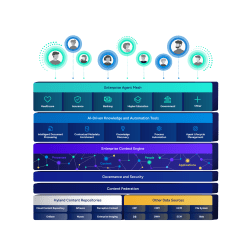5 ways an employee file management solves high-priority HR challenges
HR teams play a crucial role in managing and maintaining employee information. Here's five improvements that come with a digitized approach to employee data management.

Harness the power of a unified content, process and application intelligence platform to unlock the value of enterprise content.
Learn more
Automate your document-centric processes with AI-powered document capture, separation, classification, extraction and enrichment.
Learn about Hyland IDPIt's your unique digital evolution … but you don't have to face it alone. We understand the landscape of your industry and the unique needs of the people you serve.
 Overview of industries
Overview of industries
Countless teams and departments have transformed the way they work in accounting, HR, legal and more with Hyland solutions.
 Overview of departments
Overview of departments
We are committed to helping you maximize your technology investment so you can best serve your customers.
 Overview of services
Overview of services

Discover why Hyland is trusted by thousands of organizations worldwide.
Hear from our customers
Our exclusive partner programs combine our strengths with yours to create better experiences through content services.
Overview of partners
Find resources to power your organization's digital transformation.
Browse the resource center
Hyland connects your content and systems so you can forge stronger connections with the people who matter most.
Learn about HylandWith our modern, open and cloud-native platforms, you can build strong connections and keep evolving.
 Dig deeper
Dig deeper
An effective employee file management solution brings visibility to your most document-intensive processes. Electronic employee files are stored securely in a centralized document repository.
As a result, confidential data is protected and employee information is easily accessible from a single location.
Workflow functionality lets you easily route documents to managers, employees or other departments, and track any actions taken.
The result is better, more efficient management of the entire employee lifecycle — and all the documents that go with it.
Tracking, filing and looking up paper HR forms all consume staff time. Storing paper files requires costly office space and off-site storage. Organizations also risk losing documents in the case of fire or natural disasters.
Paper-based HR files make proving compliance difficult and time-consuming. Organizations must prove compliance with federal and state regulations or risk substantial fines.
Unstructured HR information results in duplicate documents, lost forms and slow response to compliance audits. Multiple files at regional offices, distribution centers or retail locations make it difficult to find documents and prove compliance.
Multiple systems and lack of integration with human resources information systems (HRIS) complicate access to electronic documents. HR staff members must log into different systems to gain access to the complete employee file.
Centralized management of electronic files speeds up response to audits and employee requests, allowing staff to focus on key HR issues, such as employee incentive plans, long-term hiring strategies and other important initiatives.
Electronic employee files streamline employee management from onboarding through separation. Documents are readily available for any HR process, such as a performance review, disciplinary action, leave of absence, life change events and tuition reimbursement.
Staff members can access employee files from the HRIS, applicant tracking or other programs without logging in and out of systems, which saves time and increases the value of your current systems.
HR professionals get to answer employee requests faster and streamline processes with electronic forms.
Documents are stored in an electronic document repository, freeing up storage and space and minimizing loss due to fires, floods or other disasters.

Unlock the full potential of your workforce. Discover emerging trends and technologies to enhance efficiency and collaboration.
Forms can be brought into the centralized document repository from any source, including email, fax and mail.
Workflow automatically routes documents for processing, based on work queues and tasks.
Security features restrict access to only those who need to review forms.
Records management features support automatic deletion and archiving of expired forms.
Integration features allow access to the employee file from the employee record in the HRIS.
Jessica, an HR generalist, receives a request from a manager for a copy of an employee’s annual review.
She finds the employee in your HRIS and either leverages automatic embedded search or clicks on the appropriate icon or link.
Perceptive Content returns a list of documents that have been linked to the employee’s record. Jessica selects the one she needs.
Seamless integration means just that — Perceptive Content HR solutions work smoothly within existing HR systems, including Oracle, PeopleSoft, SAP, Lawson and others, without programming.
Here’s what that looks like in real-time:
Deployment is easy with Perceptive Content as users enjoy single click access to documents from the software they’re already using daily.
